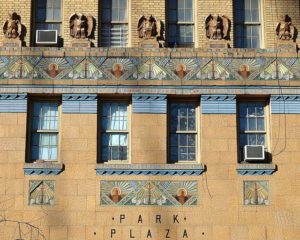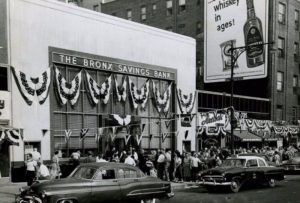The Bronx has a cluster of handsome art deco apartment houses on the southern portion of Grand Concourse (plus the “moderne” Bronx County Courthouse). Some need restoration and others, including the renowned “Fish Building”, with its glowing mosaic of an aquarium, are still looking good. The first art deco apartment house built in The Bronx (1931) is Park Plaza at 1005 Jerome Avenue (no elevated on this portion of Jerome) and W. 164th Street. Designed by architects Horace Ginsbern and Marvin Fine, Park Plaza is an eight-story structure divided into five sections. It contains 200 apartments ranging from one room to five rooms. The most prominent feature of Park Plaza is its facade embellished with magnificent art deco polychromatic designs. Developer Bernard Noonan was so impressed by Park Plaza that he commissioned Ginsbern and Fine to design Noonan Plaza some blocks north (HG recently did a nostalgic and admiring post about Noonan Plaza). Park Plaza and Noonan Plaza are both designated New York City Landmarks. The late Julien J. Studley, who created one of the country’s largest and most innovative real estate firms, was also intrigued by the elegance of Park Plaza. He bought it in the 1970’s knowing that rent control had done much damage. HG is quoted in The Studley biography, “Shaping the Skyline” by Peter Hellman: ” ‘Julien thought he would make a better world by being a caring landlord,’ said Gerry Freeman, his press agent-cum-confidant.” The tenant response to such caring was a destructive rent strike. Julien was forced to give up Park Plaza. Said Julien: “That was my first taste of total failure.”
Park Plaza
March 16th, 2020 § 0 comments § permalink
Noonan Plaza
March 10th, 2020 § 1 comment § permalink
Growing up during the Great Depression of the 1930’s, young HG would walk from the family apartment at 1210 Woodycrest Avenue, The Bronx, to elementary school, P.S. 11 on Ogden Avenue. HG would always pause and look into the courtyard of Noonan Plaza, the art deco apartment complex masterpiece which occupied most of the square bounded by W. 168th Street, Ogden Avenue and Nelson Avenue. The courtyard was magic. It contained a pool inhabited by swans and fish. There was a waterfall and the pool was crossed by rustic Japanese bridges. Noonan Plaza consisted of eight and six-story white brick buildings containing 281 apartments ranging from studios to three-bedroom units. Designed by Horace Ginsbern and Marvin Fine, architects, with much Mayan/Art Deco ornamentation on the buildings’ facades. It was built and owned by Bernard Noonan, an Irish-born real estate developer who built many apartment houses in the Highbridge section of The Bronx. Noonan Plaza opened in 1928 and was immediately occupied by upwardly mobile Jewish families fleeing the Lower East Side. Besides the design and the “moderne” bathrooms and kitchens, Noonan Plaza buildings were sited so each apartment received a maximum amount of sunshine and fresh air. Fortunately, HG’s beloved late sister, Beulah Naomi, had friends who lived in Noonan Plaza, so HG had many opportunities to visit apartments and stroll in the courtyard. It was HG’s dream to live in Noonan Plaza someday. It reminded little HG of Hollywood movies. As The Bronx decayed in later years and the middle class fled to the suburbs, Noonan Plaza did resemble a Hollywood movie.. A horror movie. It was occupied by drug addicts and drug peddlers, squatters, vagrants, etc. Much was destroyed as addicts ripped apart and sold anything that could be sold for drugs. As vandalism increased, at one point only five apartments were occupied. The last owner abandoned the complex and The New York Savings Bank, the mortgage holder, took over. Architect Frederick Ginsbern, the late Horace’s son, was dismayed at seeing his father’s masterwork destroyed. He was gratified when the bank contacted him and asked whether he had the architectural plans for the complex and would he design a restoration. It was difficult to find a builder who would do the job. Finally, Glick Construction signed on. It took two years to bring back Noonan Plaza to glory. A garden has replaced the pool. There are security gates and a manned security station. When it reopened in 1982, there were 2,000 applications for the affordable and rent-subsidized apartments. It cost $9,000,000 to reconstruct Noonan Plaza. Today, almost 20 years later, it would probably cost upwards of $100,000,000 to build a complex of this size. Noonan Plaza was designated as a New York Landmark in 2010.
The Bronx? No Thonx!
May 15th, 2018 § 0 comments § permalink
Yes, that was how the gifted master of light verse, Ogden Nash, sneered at HG’s hometown, a splendid borough. Stupid comment about a borough filled with wonders. One of the great zoos in the world. The best botanical gardens. The Bronx Community College in University Heights (the 55-acre campus was purchased from NYU in 1973) which contains outstanding architecture by Stanford White and modernist Marcel Breuer. Plus the majestic Hall of Fame, busts of famous (and not so celebrated) Americans. There’s Riverdale and Fieldston, lofty apartment houses plus distinguished houses (once occupied by people like Arturo Toscannini and Henry Morganthau). It’s a neighborhood that has housed many artists like Elie Nadelman who found studio space in the spacious residences. The Bronx has Arthur Avenue, the site of the best Italian food in the five boroughs. The Grand Concourse (and Promenade) features some of the most outstanding art deco architecture in New York. And, there’s some odd landmarks like Poe Cottage where Edgar Allen Poe allegedly composed some of his works. The Mott Haven neighborhood is now sprouting breweries and good ethnic restaurants plus the lofts are beginning to house some intrepid folk. Borough President James J. Lyons was furious at Nash’s putdown and demanded an apology. Nash apologized in 1964: “I can’t seem to escape the sins of my smart alec youth. I shudder to confess them. Now an older and wiser man I cry ‘The Bronx, God bless them'”.


